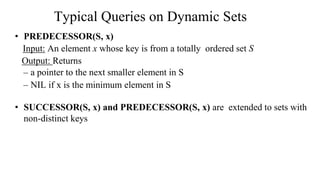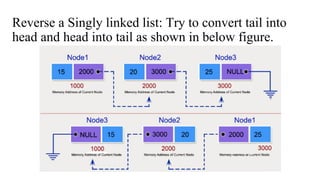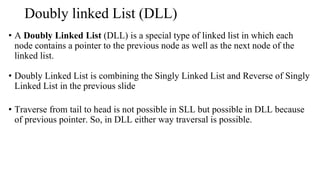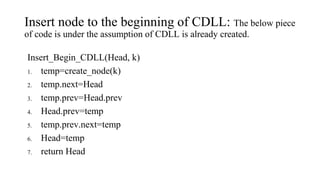14_linked list_updated-updated-updated(1).pdf
- 1. CS1011E:Program Design Dynamic Memory Allocation & Linked List
- 2. Problem with Arrays • Sometimes ◻Amount of data cannot be predicted beforehand ◻Number of data items keeps changing during program execution • Example: N Number of employees in an organization(Increase/Decrease) • One solution: find the maximum possible value of N and allocate an array of N elements ◻Wasteful of memory space, as N may be much smaller in some executions ◻Example: maximum value of N may be 10,000, but a particular run may need to search only among 100 elements ◻Using array of size 10,000 always wastes memory in most cases
- 3. Better Solution • Dynamic memory allocation ◻Know how much memory is needed after the program is run • Example: ask the user to enter from keyboard ◻Dynamically allocate only the amount of memory needed • C provides functions to dynamically allocate memory ◻malloc, calloc, realloc
- 4. Dynamic Data Sets • Sets can – grow – shrink – change their size over time • Such sets are called Dynamic Sets
- 5. Operations on Dynamic Sets Dynamic operations grouped into two categories: – Queries: return information about the sets – Modifying operations: change structure of the sets
- 6. Typical Queries on Dynamic Sets • SEARCH(S, k) Input: A set S and a key value k Output: Returns – a pointer x to an element in S such that x.key = k OR – NIL if no such element belongs to S • MINIMUM(S): Input: A totally ordered set S Output: – Returns a pointer to the element of S with the smallest key
- 7. • MAXIMUM(S) Input: A totally ordered set S Output: – Returns a pointer to the element of S with the largest key • SUCCESSOR(S, x) Input: An element x whose key is from a totally ordered set S Output: Returns – a pointer to the next larger element in S – NIL if x is the maximum element in S Typical Queries on Dynamic Sets
- 8. • PREDECESSOR(S, x) Input: An element x whose key is from a totally ordered set S Output: Returns – a pointer to the next smaller element in S – NIL if x is the minimum element in S • SUCCESSOR(S, x) and PREDECESSOR(S, x) are extended to sets with non-distinct keys Typical Queries on Dynamic Sets
- 9. Modifying operations on Dynamic Sets • INSERT(S, x) Input: A set S and a pointer to x (Assume that an attribute of x is already initialized) Output: – Augments S with the element pointed by x • DELETE(S, x) Input: A set S and a pointer to x (not a key value) Output: Removes x from S
- 10. Dynamic Sets • Each element is represented by an object – A pointer to the object is used for examining and manipulating the objects’ attributes • Dynamic sets assume, one of the objects attribute is an identifying key
- 11. Dynamic Sets • The object may contain satellite data, which are carried around in other object attributes • Object attributes - manipulated by set operations – Attributes may contain data or pointers to other objects in the set • Some dynamic sets – keys from a totally ordered set
- 12. Dynamic Memory Allocation Functions • malloc() ◻Allocates requested number of bytes and returns a pointer to the first byte of the allocated space • calloc() ◻Allocates space for an array of elements, initializes them to zero and then returns a a base pointer of the memory. • free() ◻Frees previously allocated space. • realloc() ◻Modifies the size of previously allocated space
- 13. Allocating a Block of Memory • A block of memory can be allocated using the function malloc() ◻Reserves a block of memory of specified size and returns a pointer of type void ◻The return pointer can be type-casted to any pointer type • General format: datatype *ptr = (cast type *) malloc (size*size of(datatype)); Eg: int *ptr=(int*)malloc(5*size of(int));
- 14. 14 Example p = (int *) malloc(100 * sizeof(int)); ◻ A memory space equivalent to 100 times the size of an int bytes is reserved ◻The address of the first byte of the allocated memory is assigned to the pointer p of type int p 400 bytes of space
- 15. Cont… • cptr = (char *) malloc (20); Allocates 20 bytes of space for the pointer cptr of type char • sptr = (struct stud *) malloc(10*sizeof(struct stud)); Allocates space for a structure array of 10 elements. sptr points to a structure element of type struct stud Always use sizeof operator to find number of bytes for a data type, as it can vary from machine to machine
- 16. Cont… • malloc() always allocates a block of contiguous bytes ◻The allocation can fail if sufficient contiguous memory space is not available ◻If it fails, malloc() returns NULL if ((p = (int *) malloc(100 * sizeof(int))) == NULL) { printf (“n Memory cannot be allocated”); exit(); }
- 17. Releasing the Allocated Space: free() • An allocated block can be returned to the system for future use by using the free function • General syntax: free (ptr); where ptr is a pointer to a memory block which has been previously created using malloc() • Note that no size needs to be mentioned for the allocated block, the system remembers it for each pointer returned
- 18. calloc() calloc() • datatype *ptr=(cast type *)calloc(size, sizeof(each datatype)); Eg: int *ptr=(int *)calloc(5,sizeof(int)); • Here each bit is initialized with zero
- 19. realloc() is to resize the memory allocated using malloc() or calloc() realloc() *ptr=(int *)realloc(ptr,10*size of(int)); …. …. free(ptr); //Clear the ptr after all its use
- 20. Data Structures: A data structure is a way of organizing and storing data in a computer so that it can be accessed and used efficiently. Types Data Structure: • 1. Linear Data Structure: Stacks, Queues, Linked List(SLL,DLL,CLL,CDLL) • 2. Non-Linear Data Structure: Trees, Graphs
- 21. Linked List • Linked list is a data structure in which objects are arranged in a linear order – Linear order is determined by a pointer in each object • Provides a simple, flexible representation for dynamic sets and it supports all the operations (query & modifications) • Different types of linked list: – Singly Linked List (SLL) – Doubly Linked List (DLL) – Circular Linked List(CLL) – Circular Doubly Linked List (CDLL)
- 22. Cont… • A linked list is simply a chain of structures which contain a pointer to the next element and it is dynamic in nature • Items may be added to it or deleted from it. • A list item has a pointer to the next element, or NIL if the current element is the tail (end of the list). • Pointer to the next element points to a structure of the same type as itself. • This structure that contains elements and pointers to the next structure is called a Node. • The first node is always used as a reference to traverse the list and is called HEAD. The last node(Tail) which points to NIL at the pointer.
- 23. Declaring a Linked list Declaring a Linked list : struct SLL{ int data; struct SLL *next; }; • The above definition is used to create every node in the list. • The data field stores the element and the next is a pointer to store the address of the next node. • In place of a data type, struct LinkedList is written before next. That's because its a self-referencing pointer. It means a pointer that points to whatever it is a part of. • Here, next is a part of a node and it holds a poiter to the next node.
- 24. SINGLY LINKED LIST (SLL) 10 Key Field Next Field Each element of SLL : An object Attributes: Key and a Next pointer. Head.data=40, Head.next= pointer to the next Node 20 30 40 Head Tail
- 25. Cont… • For every linked list there is a head node and there is a tail node • Head.key hold the data value • Head.next hold the address • In a dynamic dataset like linked list the term ‘query’ is used to get a response about list and the term ‘modification’ means insert or delete some element into list.
- 26. Cont… • An attribute Head points to the first element of the list. • If Head = NIL, the list is empty • Given an element x in the list, x.next points to its successor in the linked list • If x.next = NIL, the element x has no successor and is therefore the last element, or tail, of the list.
- 27. Creation of Singly Linked List struct SLL *Head=NIL; typedef struct SLL node; create_SLL(Head, k) 1. x=create_node(k) 2. if(Head==NIL) 3. Head=x 4. Tail=x else 5. Tail.next=x 6. Tail=x Creating a node and return its pointer if memory created otherwise return NIL create_node(k) 1. Allocate dynamic memory to temp //node temp=(node)malloc(size of(node)) 2. if(temp==NIL) 3. print “Memory not available”; 4. exit else 5. temp.key=k 6. temp.next=NIL 7. return temp
- 28. Print Linked List • Print_SLL prints the SLL by copying the Head into x. x travelling from Head to till NIL by printing the data present at each node. Print_SLL(Head) 1. x=Head 2. while x ≠NIL 3. print x.key 4. x=x.next
- 29. SLL Cont… • The operations performed on a Singly linked list are : • Create SLL • Print SLL • Length of SLL • Insert a node (Begin, Middle, End) • Delete a node(Begin, Middle, End) • Search an element k in SLL • predecessor • successor • minimum • maximum
- 30. Print length of a Singly linked list Length_SSL(Head) 1. count=0 2. x=Head 3. while(x≠NIL) 4. x=x.next 5. count=count+1 6. print count
- 31. Search Operation • The procedure search(Head, k) finds the first element with key k in list by a simple linear search, returning a pointer of the node having this key ‘k’. • If no object with key ‘k’ appears in the list, then the procedure returns NIL. • Time complexity of linear search and time complexity of search in a linked list are same.
- 32. Psuedocode of Search_SLL Search_SLL(Head, k) 1. x=Head 2. while x≠NIL and x.data≠k 3. x=x.next 4. return x
- 33. Insertion of a node in a linked list • Insertion at the beginning of the list. • Insertion at the end of the list • Inserting a new node except the above mentioned positions.
- 34. Inserting a node at begin: Inserting a node under the assumption of SLL is already created. Insert_Begin (Head, k) 1. newnode=create_node(k) 2. newnode.next=Head 3. Head=newnode 4. return Head
- 35. Inserting a node in SLL at middle Insert_Middle(Head, k, position) 1. L=Length_SSL(Head) 2. newnode=create_node(k) 3. if pos≥2 and pos<L 4. x=Head 5. for j=2 to pos-1 6. x=x.next 7. newnode.next=x.next 8. x.next=newnode else 9. print “Invalid position” 10. return 0
- 36. Inserting a node at end of SLL Insert_End(Head, k) 1. newnode=create_node(k) 2. x=Head 3. while(x.next≠NIL) 4. x=x.next 5. x.next=newnode 6. tail=newnode
- 37. Delete a node from SLL at beginning Delete_Begin(Head) 1. x=Head 2. Head=Head.next 3. print “x.data” 4. free(x) //free the memory pointed by x pointer
- 38. Delete a node from SLL at Middle Delete_Middle(Head, pos) //(pos) is position of a node 1. L=Length_SLL(Head) 2. if pos≥2 and pos<L 3. x=Head 4. for j=2 to pos-1 5. x=x.next 6. temp=x.next 7 x.next=x.next.next 8. print “temp.data” 9. free(temp) else 10. print “invalid position” 11. return 0
- 39. Delete a node from SLL at ending Delete_End(Head) 1. x=Head 2. while(x.next.next ≠ NIL) 3. x=x.next 4. temp=x.next 5. x.next=NIL 6. print “temp.data” 7. free temp
- 40. Reverse a Singly linked list: Try to convert tail into head and head into tail as shown in below figure.
- 41. CIRCULAR LINKED LIST (CLL): Tail’s pointer points to the Head node instead of NIL. 10 • Each element of CLL : An object • Attributes: Key and a Next pointer. Head.data=40, Head.next= pointer to the next Node • Reader can take all the functions of CLL as an exercise. 20 30 40 Head Tail
- 42. Doubly linked List (DLL) • A Doubly Linked List (DLL) is a special type of linked list in which each node contains a pointer to the previous node as well as the next node of the linked list. • Doubly Linked List is combining the Singly Linked List and Reverse of Singly Linked List in the previous slide • Traverse from tail to head is not possible in SLL but possible in DLL because of previous pointer. So, in DLL either way traversal is possible.
- 43. NIL 1 2500 2000 2 1500 2500 3 NIL Prev 2000 2500 1500 Tail Head key next Appearance of Doubly linked List (DLL)
- 44. Creation of DLL struct DLL { // structure of a node struct DLL *next int key struct DLL *prev }; typedef struct DLL node; node *Head=*Tail=NIL // Initialization of Head and Tail create_DLL(Head, k, Tail) 1. Newnode=create_node(k) 2. if (Head==NIL) 3. Head=Newnode 4. Tail=Newnode 5 return Head else 6. Tail.next=Newnode 7. Newnode.prev=Tail 8. Tail=Newnode 9. return tail create_node(k) 1. Allocate dynamic memory to temp //node temp=(node *)malloc(sizeof(node)) 2. If (temp==NIL) 3. print “Memory not available”; 4. exit else 5. temp.key=k 6. temp.prev=NIL 7. temp.next=NIL 8. return temp Creating a node and return its pointer if memory created otherwise return NIL
- 45. Printing DLL from Tail using prev pointer print_DLL(Tail) 1. x=Tail 2. while x ≠ NIL 3. print “x.key” 4. x=x.prev
- 46. DLL Insertion at Middle In case of DLL, we can travel either from Head to Tail or Tail to Head. Assume that x is pointing before node where new node to be inserted using position (pos) while travelling from Head. Newnode points the node to be inserted. Then 1. Newnode.next=x.next 2. Newnode.prev=x 3. Newnode.next.prev=Newnode 4. x.next=Newnode Reader should complete the pseudocode by taking the above piece of code.
- 47. DLL Deletion at Middle In case of DLL, we can travel either from Head to Tail or Tail to Head. Assume that x is pointing before node of delete node while travelling from Tail. 1. temp=x.prev 2. x.prev=temp.prev 3. x.prev.next=x 4. print “temp.key” 5. free(temp) Reader should complete the pseudocode by taking the above piece of code.
- 48. Circular Doubly Linked List • Circular Doubly Linked List has properties of both doubly linked list and circular linked list in which two consecutive elements are linked or connected by the previous and next pointer and the last node points to the first node by the next pointer and also the first node points to the last node by the previous pointer. • For all operations of a Circular Doubly Linked List Head.prev and Tail.next should be replaced always.
- 49. Structure of CDLL 1500 1 2500 2000 2 1500 2500 3 2000 Prev 2000 2500 1500 Tail Head key next
- 50. Create a CDLL: reuse the create_node function discussed during DLL. Create_CDLL(Head, Tail, k) 1. temp=create_node(k) //temp is newnode to be part of CDLL 2. if Head==NIL 3. Head=temp 4. Tail=temp 5. Tail.prev=temp 6. Tail.next=temp else 7. temp.next=Tail.next 8. Tail.next=temp 9. temp.prev=Tail 10. Head.prev=temp 11. Tail=Temp 12. return Head, Tail // use call by reference to replicate both the pointers
- 51. Insert node to the beginning of CDLL: The below piece of code is under the assumption of CDLL is already created. Insert_Begin_CDLL(Head, k) 1. temp=create_node(k) 2. temp.next=Head 3. temp.prev=Head.prev 4. Head.prev=temp 5. temp.prev.next=temp 6. Head=temp 7. return Head
- 52. Cont… • We can use both Head and Tail to insert a node in circular doubly linked list. • In CDLL 4 pointers get affected to insert a node at beginning, but in DLL only 2 pointers get affected
- 53. Insert a node to the end of a CDLL Insert_End_CDLL(Tail, k) 1. temp=create_node(k) 2. temp.next=Tail.next 3. temp.prev=Tail 4. temp.next.prev=temp 5. Tail.next=temp 6. Tail=temp 7. return Tail
- 54. Cont… • In case of inserting a node at the middle of a CDLL, Head.prev or Tail.next is not get affected. So, Insert_Middle_CDLL=Insert_Middle_DLL
- 55. Delete a node at the beginning of a CDLL Delete_Begin_CDLL(Head) 1. temp=Head 2. Head=Head.next 3. Head.prev=temp.prev 4. temp.prev.next=Head 5. print “temp.key” 6. free(temp)
- 56. Delete a node at the End of a CDLL by passing Tail node as the parameter Delete_End_CDLL(Tail) 1. temp=Tail 2. Tail=Tail.prev 3. Tail.next=temp.next 4. Tail.next.prev=Tail //alternate stmt is Temp.next.prev=Tail 5. Print “temp.key” 6. free(temp)
- 57. Thank you
























































